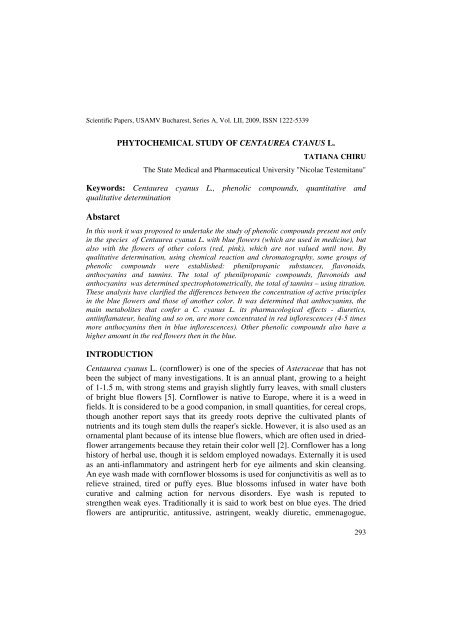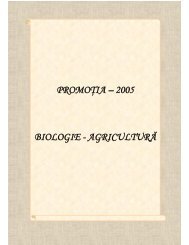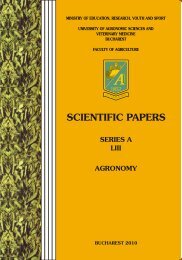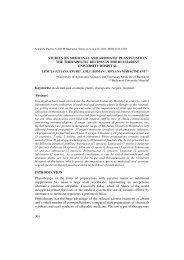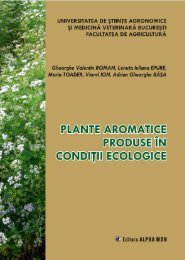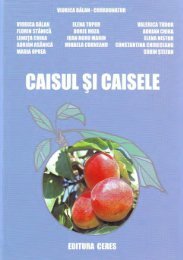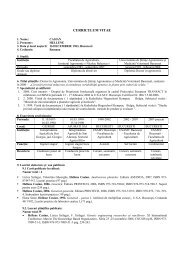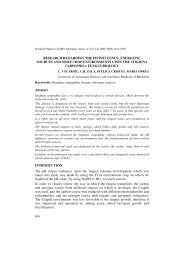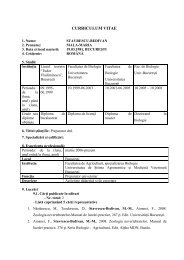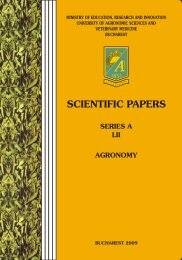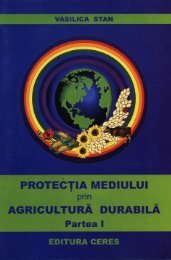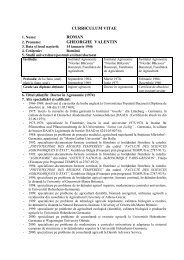phytochemical study of centaurea cyanus l
phytochemical study of centaurea cyanus l
phytochemical study of centaurea cyanus l
Create successful ePaper yourself
Turn your PDF publications into a flip-book with our unique Google optimized e-Paper software.
Scientific Papers, USAMV Bucharest, Series A, Vol. LII, 2009, ISSN 1222-5339PHYTOCHEMICAL STUDY OF CENTAUREA CYANUS L.TATIANA CHIRUThe State Medical and Pharmaceutical University "Nicolae Testemitanu"Keywords: Centaurea <strong>cyanus</strong> L., phenolic compounds, quantitative andqualitative determinationAbstarctIn this work it was proposed to undertake the <strong>study</strong> <strong>of</strong> phenolic compounds present not onlyin the species <strong>of</strong> Centaurea <strong>cyanus</strong> L. with blue flowers (which are used in medicine), butalso with the flowers <strong>of</strong> other colors (red, pink), which are not valued until now. Byqualitative determination, using chemical reaction and chromatography, some groups <strong>of</strong>phenolic compounds were established: phenilpropanic substances, flavonoids,anthocyanins and tannins. The total <strong>of</strong> phenilpropanic compounds, flavonoids andanthocyanins was determined spectrophotometrically, the total <strong>of</strong> tannins – using titration.These analysis have clarified the differences between the concentration <strong>of</strong> active principlesin the blue flowers and those <strong>of</strong> another color. It was determined that anthocyanins, themain metabolites that confer a C. <strong>cyanus</strong> L. its pharmacological effects - diuretics,antiinflamateur, healing and so on, are more concentrated in red inflorescences (4-5 timesmore anthocyanins then in blue inflorescences). Other phenolic compounds also have ahigher amount in the red flowers then in the blue.INTRODUCTIONCentaurea <strong>cyanus</strong> L. (cornflower) is one <strong>of</strong> the species <strong>of</strong> Asteraceae that has notbeen the subject <strong>of</strong> many investigations. It is an annual plant, growing to a height<strong>of</strong> 1-1.5 m, with strong stems and grayish slightly furry leaves, with small clusters<strong>of</strong> bright blue flowers [5]. Cornflower is native to Europe, where it is a weed infields. It is considered to be a good companion, in small quantities, for cereal crops,though another report says that its greedy roots deprive the cultivated plants <strong>of</strong>nutrients and its tough stem dulls the reaper's sickle. However, it is also used as anornamental plant because <strong>of</strong> its intense blue flowers, which are <strong>of</strong>ten used in driedflowerarrangements because they retain their color well [2]. Cornflower has a longhistory <strong>of</strong> herbal use, though it is seldom employed nowadays. Externally it is usedas an anti-inflammatory and astringent herb for eye ailments and skin cleansing.An eye wash made with cornflower blossoms is used for conjunctivitis as well as torelieve strained, tired or puffy eyes. Blue blossoms infused in water have bothcurative and calming action for nervous disorders. Eye wash is reputed tostrengthen weak eyes. Traditionally it is said to work best on blue eyes. The driedflowers are antipruritic, antitussive, astringent, weakly diuretic, emmenagogue,293
ophthalmic, very mildly purgative, and tonic. An infusion can be used in thetreatment <strong>of</strong> dropsy, constipation, or as a mouthwash for ulcers and bleeding gums.This infusion is also taken as a bitter tonic and stimulant, improving the digestionand possibly supporting the liver as well as improving resistance to infections.Water distilled from the marginal flowers was formerly in repute as a remedy forweak eyes and a soothing lotion for conjunctivitis. The seeds are used as a mildlaxative for children. Cornflower leaves are used to create a cleansing facial steamfor dry sensitive skin. A decoction <strong>of</strong> the leaves is antirheumatic. These effects aredetermined by the presence <strong>of</strong> the phenolic compounds (flavonoids, tannins, caffeicand chlorogenic acids), which are very poorly studied in C. <strong>cyanus</strong> L. [9].Phenolic compounds are ubiquitous constituents <strong>of</strong> higher plants found in a widerange <strong>of</strong> commonly consumed plant foods such as fruits, vegetables, cereals andlegumes. They are diverse in structure but are characterized by hydroxylatedaromatic rings. These compounds are secondary metabolites <strong>of</strong> plants generallyinvolved in defense against ultraviolet radiation or aggression by pathogens. Theyhave been the subject <strong>of</strong> a great number <strong>of</strong> chemical, biological, agricultural andmedical studies. Plant phenolics have received considerable attention because <strong>of</strong>their potential antioxidant activity as well as hepatoprotective, hypoglycemic andantiviral activities. Human consumption <strong>of</strong> antioxidants has many alleged healthbenefits, including protection against cardiovascular diseases, and, most recently,cancer [1, 4]. Therefore the studies <strong>of</strong> the plants, which are sources <strong>of</strong> phenoliccompounds represent a great actuality.MATERIAL AND METHODSPlant materials (aerial parts, inflorescences, marginal and disc flowers) werecollected during the flowering period from the South <strong>of</strong> Basarabia in June, 2008.After powdering, these materials have been exposed to physico-chemical analysis.The phenilpropanic compounds were identified by thin-layer chromatography [7].1 g <strong>of</strong> plant material was extracted by refluxing with 10 ml methanol andconcentrated to 4 ml. Operating conditions were as follows:• mobile phase: ethyl acetate–acetic acid–formic acid–water (100:11:11:26);294• stationary phase: silica gel plate;• etalon solutions: caffeic and chlorogenic acids;• identification in visible and UV specter.The total <strong>of</strong> the phenilpropanic compounds in blue and purple inflorescences, inaerial parts with blue an purple inflorescences <strong>of</strong> C. <strong>cyanus</strong> L., was determinedusing spectrophotometric analysis, at 500 nm wavelength (caffeic acid as referencesubstance) [7]: 4.0000 g powdered plant material with 80 ml ethylic alcohol 50% isput in a bottle, weighted and extracted in reflux during 30 min. After cooling, thebottle is restored to the initial weight with ethylic alcohol 50% and filtrated
(solution A). 5 ml <strong>of</strong> solution A is diluted in a 50 ml marked bottle with ethanol50%. To 1 ml <strong>of</strong> this solution are added: 1 ml chlorhydric acid 0.5 n, 1 ml Arnowreactive, 1 ml NaOH 1 n and it’s filled with water till the 10 ml mark in a markedbottle (resulting a red solution). After 10 min the absorbance is determined incomparison with the following solution: 0.5 ml solution A, 1 ml HCl 0.5 n, 1 mlNaOH 1 n and water till 10 ml mark.For the quantitative determination <strong>of</strong> tannins (in aerial parts and blueinflorescences), was employed the titrimetric method [3], based on its oxidationwith potassium permanganate: 2 g <strong>of</strong> plant materials with 50 ml boiling water arewarmed up. After 30 min the solution is filtrated in a bottle with 250 ml volume.The extraction is repeated until tannins reaction (with ferric alum) is negative. Thebottle containing the cold solution is filled with water to the marked level (250 ml)and is transferred in a 1 l bottle, 750 ml water and 25 ml acid indigosulphonicsolution are added. Then it is titrated with potassium permanganate 0.1 n until thesolution becomes yellow. Similarly the control probe (25 ml indigosulphonic acidin 750 ml water) is titrated. The total quantity <strong>of</strong> tannins is calculated using theformula:( V1−V2) K ⋅ D ⋅V⋅100⋅100x =mV 100 − ω3( )V 1 – used volume <strong>of</strong> potassium permanganate 0.1 n, ml; V 2 – used volume <strong>of</strong>potassium permanganate 0.1 n for the titration <strong>of</strong> the control probe, ml; K – thecorrection to the titer (via oxalic acid); D – the coefficient <strong>of</strong> tannin; V – the totalvolume <strong>of</strong> the extract, ml; m – the exact mass <strong>of</strong> plant material, g; V 3 – volume <strong>of</strong>extract used for titration, ml.RESULTS AND DISCUSSIONBy qualitative determination, using chemical reaction and chromatography, somegroups <strong>of</strong> phenolic compounds were established: phenilpropanic substances [7],flavonoids [6, 10], anthocyanins [6, 8] and tannins [3] (reaction with ferric alumproves that tannins are condensated). The caffeic and chlorogenic acids weredetermined qualitatively in blue and purple inflorescences, in aerial parts with bluean purple inflorescences <strong>of</strong> C. <strong>cyanus</strong> L., using thin–layer chromatography.The results <strong>of</strong> quantitative analysis, obtained in our actual and previous studies [6],are listed in table 1.In the scientific medicine only the blue flowers <strong>of</strong> C. <strong>cyanus</strong> L., but not othersexemplars (with purple, pink or white inflorescences), are employed. Strikingly,these exemplars generally are ignored and not studied, their unique utilization is asornamental plants. According to our investigations in the purple flowers the content<strong>of</strong> active agents is higher than their level in the blue flowers (table 1). In this case295
the obtained pharmaceutical products from purple flowers <strong>of</strong> C. <strong>cyanus</strong> L. can bemore economically (efficiently). Sure is the fact that additional studies are needed.Plant materialInflorescencesDisc flowersMarginalflowersAerial partsResults <strong>of</strong> quantitative analysisAnthocyanin(%)Phenilpropaniccompounds(%)Tannins(%)Table 1Flavonoids(%)purple 1.3574 0.360 0.206blue 0.2418 0.150 0.291 0.193pink 0.0700 0.218purple 2.2534 0.212blue 0.4916 0.175pink 0.1909 0.193purple 3.6313 0.218blue 0.6716 0.112pink 0.2330purple 0.240 0.262blue 0.313 4.656 0.218radix 0.093fruits 0.112CONCLUSIONSOur investigations prove that:1. A great importance in the content <strong>of</strong> active principles makes the colour <strong>of</strong> theflowers:• the highest concentration <strong>of</strong> flavonoids are determined in purple flowers(0.21 – 0.22%), next – pink flowers (0.19%) and the lowest – in blueflowers (actually used in medicine); in pink – 0.22%, purple – 0.2% andblue inflorescences – 0.17%;• anthocyanins highest concentration is in purple (1.36 – 3.63%), in blue –(0.24 – 0.67%) and in pink flowers and inflorescences – (0.07 – 0.23%);• in purple inflorescences the concentration <strong>of</strong> phenilpropanic compoundsis higher (0.36%) than in blue inflorescences (0.15%), but in aerial partswith purple inflorescences is lowest (0.24%) than in aerial parts withblue inflorescences (0.31%).296


